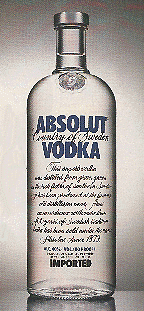A Guide to Drugs and the Brain
Commentary
Drug Effects
Drug Research
Drug Street Names
Back to NFIA
Alcohol
Alcohol comes
in many forms, including liquor (bourbon,
(bourbon,
gin, scotch), beer, wine, and wine coolers. In general,
one ounce of liquor, one beer, and one glass of wine
(5 ounces) contain equal amounts of alcohol.
Effects
Alcohol acts on the brain and can produce addiction. Short-term effects:
The more a person drinks in one sitting, the more pronounced short-term
effects become. Small amounts (1-2 drinks) generally produce pleasant
feelings. Larger  amounts
produce depressant effects on the brain. Judgment, reaction time, speech
and motor control are increasingly impaired with increasing amounts of
alcohol. Drunk drivers kill about 23,000 Americans a year. Very large
amounts of alcohol can cause death from overdose by reducing the number
of messages the brain sends to the chest muscles that regulate breathing.
The drinker stops breathing and dies. Long-term effects: Over time, alcohol
can produce tolerance, physical dependence and addiction. Alcohol can
cause many kinds of cancer and can permanently damage the brain. In severe
cases, alcohol destroys the part of the brain where short-term memory
occurs, making it impossible to learn anything new. Women should not drink
during pregnancy. Fetal alcohol syndrome is the leading, preventable cause
of mental retardation in the United States.
amounts
produce depressant effects on the brain. Judgment, reaction time, speech
and motor control are increasingly impaired with increasing amounts of
alcohol. Drunk drivers kill about 23,000 Americans a year. Very large
amounts of alcohol can cause death from overdose by reducing the number
of messages the brain sends to the chest muscles that regulate breathing.
The drinker stops breathing and dies. Long-term effects: Over time, alcohol
can produce tolerance, physical dependence and addiction. Alcohol can
cause many kinds of cancer and can permanently damage the brain. In severe
cases, alcohol destroys the part of the brain where short-term memory
occurs, making it impossible to learn anything new. Women should not drink
during pregnancy. Fetal alcohol syndrome is the leading, preventable cause
of mental retardation in the United States.
Common Street
Names
Juice, cold ones, brewskies, poison, booze, hooch, sauce.
Legal Status
In the United States, it is legal to produce and sell alcohol to adults
and legal for adults to buy it. It is illegal to sell alcohol to those
under age 21, and illegal for them to buy it.
About • Site Map • Privacy
© Copyright 2001 National Families in Action. All rights reserved.
Questions? Write to nfia@nationalfamilies.org.
